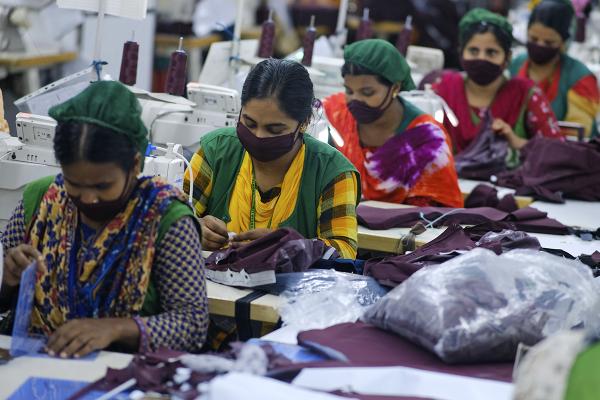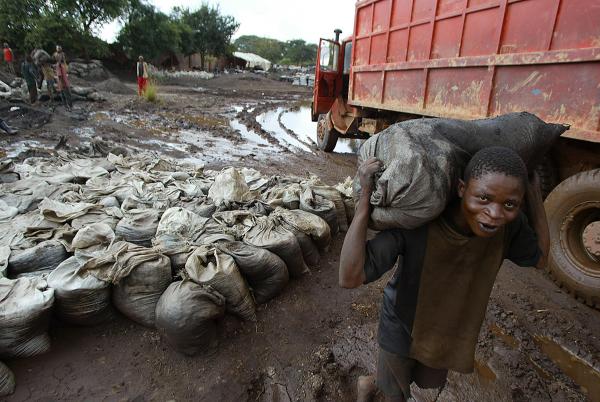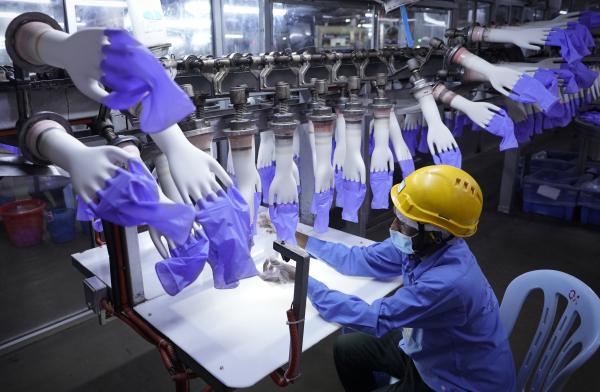Over the holidays, and continuing, the news has been full of stories about what is referred to as a breakdown in the “global supply chain.” In the U.S. this has impacted availability of everything from cars to essential medicines and supplies to fight COVID. And the impact worldwide has greatly intensified global inequality and suffering, far beyond what people in countries like the U.S. are experiencing. But the way this is being covered in mainstream (ruling class) media covers over the essence of what is going on, why it is happening, and where people’s interests lie.
Case in point: a piece in the New York Times at the end of last year titled “How the Supply Chain Crisis Unfolded.” It paints a picture of “Ships stuck at sea, warehouses overflowing, trucks without drivers: The highly intricate and interconnected global supply chain is in upheaval, with little end in sight.” And the article cites, as an example, how “the need to ship surgical masks to West Africa from China can have a cascading effect on Ford’s ability to put back-up cameras on its cars at factories in Ohio and delay the arrival of Amazon Prime orders in Florida in time for the holidays.” The “take-home” message of the piece is that all this is the result of “just in time” production (a method that relies on minimizing on-hand stock and ordering just enough parts to keep assembly lines and distribution channels functioning for the next week, day or hours).
The Times article sheds a bit of light on the insanity of how things are produced and distributed in the world as it is. But it covers up the ferociously unequal way this “supply chain crisis” is impacting a world of already-existing savage inequalities. And even more fundamentally, it covers up the driving force behind all the chaos in production and distribution triggered by COVID.

During the deadliest surge of the pandemic, the 15,000 workers at a clothing factory in Bangladesh were required to walk through a “disinfectant tunnel” in which they are sprayed with sanitizer before they began work. Photo: AP
Global Supply Chains in a World of Savage Inequality
Let’s start with what a supply chain is. Supply chains connect production units (like factories, mines, and farms); transport (like ships, trains, and trucks), and warehouses and distribution (through stores and online distributors like Amazon). But, unlike the picture painted in the Times, supply chains are not just some sort of technically efficient means of carrying out business making it possible for products to get produced and marketed. Supply chains are networks of exploitation, fundamentally based on brutal super-exploitation of people in the oppressed nations of the global South—with wages at bare survival and below, and horrendous working conditions.
Take Apple for example, that supposed shining example of the glories of American entrepreneurship. Apple’s stock is now worth $3 trillion after consumers, especially in the U.S. and other rich countries, purchased Apple devices for work, to communicate, and entertain themselves during the COVID pandemic. Apple’s “achievement” of obscenely profiting from chaos and disruption caused by COVID is being celebrated in the financial pages.1 But along with profiting from the COVID crisis, this “achievement” was built on a supply chain that crushes the bodies and spirits of people in Asia and Africa.

40,000 children dig tunnels and haul rocks from cobalt mines in the Democratic Republic of Congo. Cobalt is an essential mineral for the lithium-ion batteries used in electric vehicles, laptops and smart phones. Photo: AP
Some 40,000 children dig tunnels and haul rocks from cobalt mines in the Democratic Republic of Congo―to provide a mineral essential to Apple products.2 And despite repeated exposures of conditions in the factories that assemble iPhones, and promises by Apple to improve conditions, at the end of 2021, women who assemble Apple products at a 17,000-worker factory in southern India were packed into dorm rooms where as many as 30 women slept on the floor, without flush toilets, eating food sometimes crawling with worms that sickened over 250 of them and sent 100 to the hospital. These women make about $140 a month before “room and board” is deducted from their pay.3
In fixating on the disruption of deliveries of new cars and packages from Amazon to people in the U.S., the Times piece barely acknowledges the impact of the COVID-triggered breakdown in the global “supply chain” on what was already vastly unequal distribution of COVID vaccines and medical supplies in Africa.4 Not to mention the fact that certain key medical supplies, like protective masks, are subcontracted to sweatshops in Malaysia, then shipped to rich countries.5

Certain key supplies, like protective equipment, have been subcontracted for production in sweatshop factories in Malaysia, then shipped to the rich countries. Photo: AP
And the Times piece says nothing about the terrible impact of COVID-triggered disruption of distribution channels on the world’s fragile food supply chain where as many as 2.37 billion people―one in every three on the planet―did not have access to adequate food in 2020. 6
What’s Behind the Insanity of Capitalism-Imperialism
And then we get to coverup #2 in the Times article: reducing the disruption in global production and distribution to the adoption of “just in time” production methods by short-sighted companies. As if more far-sighted management of inventories could eliminate the chaos and anarchy revealed in some stark ways by this supply chain crisis.
The reality is that rational, society-wide economic planning is impossible under capitalism.
One of the profound contributions of Bob Avakian’s new communism is identifying the “driving force of anarchy” in how capitalism operates.7 Here, what is meant by “anarchy” is not the movement of anarchists who see themselves as opponents of capitalism. Here, anarchy refers to the fact that a core feature of capitalism is that there is not and cannot be conscious planning of production and as a whole under capitalism. There is no coordination and cooperation. Instead, different blocks of capital (corporations and banks, etc.) pursue their private interests and drive for profit in dog-eat-dog, do-or-die competition with others.

COVID-triggered disruption of distribution channels on the world’s fragile food supply chain where as many as 2.37 billion people—one in every three on the planet— did not have access to adequate food in 2020. In Ethiopia where thousands faced famine, a mother holds a malnourished child. Photo: AP
And this anarchy casts its net over a world of highly organized production and distribution. Producing a car, for example, is dependent on a “chain” (double meaning intended) linking technicians and designers in Silicon Valley, coders in India, immigrant workers in the Middle East oil fields,8 the child laborers in the mines of Congo, dock workers loading and unloading ships to and from China… so that (to go back to the NY Times example), a Ford vehicle can roll off the assembly line in Chicago with a backup camera installed.
Like rival gangs clashing over supply and distribution of drugs, but on an exponentially more massive and destructive scope and scale, each individual block of capital is driven to maximize its own profit on a short-term basis ... or get crushed or swallowed up by rivals. And the supply chains that the Times writes about are not neutral channels of commerce, they are weapons in the competitive battle of imperialist capital for winning market share.
Any capitalist who tried to implement policies based on demanding humane working conditions, real environmental responsibility, or producing products based on human need rather than maximizing profit would be immediately “brought back into line”—not only by investors who would not stand by while competitors took advantage of such decisions, but by the very workings of capitalism itself, which spawns dog-eat-dog competition.9
Capitalism-imperialism is not a system that takes the “long view” of anticipating and preparing for natural disasters and emergencies... of allocating appropriate resources for public health and well-being... of putting the interests of world humanity first... and protecting the ecosystems of the planet.
The toxic and explosive combination of highly organized production (like Apple subcontracting to thousands of suppliers, imposing strict efficiency standards) and the all-consuming competitive, anarchic struggle for profit by privately-controlled blocks of capital (individual corporations, banks, etc.) is the essence of why capitalism can never be reformed, moderated, regulated, or pressured into bringing about any meaningful, lasting change for the better.
But understanding this dynamic opens the door to the solution: a society where the tremendous technology in the world and knowledge and creativity of people can be utilized and unleashed socially for the betterment of humanity and saving the planet. How such a society could be established and function is set forth in the visionary Constitution for a New Socialist Republic in North America authored by Bob Avakian. How to get there: revolution.
